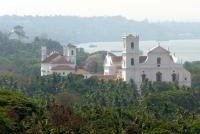
In Goa Velha we occasionally had to pinch ourselves to remember that we were in tropical India rather than Latin America – but there were large numbers of Indians in church and wearing saris to prove it!
Overall Goa Velha exceeded our expectations - but these were perhaps not that high to start with. We were more carrying out a duty visit based on “list counting” than from any urgent desire to see the site!! This now consists of a series of churches and convents laid out pleasantly over a wide area among landscaped gardens and tropical forests – a very relaxing place to visit with bright greens (trees and lawns), blues (sky and river) and whites (most churches!). There are no significant remains of any habitation from the early days of the old city although there were signs that richer Goans were currently building plush villas among the trees. The capital was officially moved to Panjim in 1843 but the churches had begun to suffer earlier in 1835 when Portugal initiated a series of actions against the religious orders. The ruined church of St Augustine dates from these activities
Goa’s capture by the Alphonso de Albuquerque from its Muslim ruler took place as early as 1510 – Cortes didn’t overcome the Aztecs until 1520 and Pizarro the Incas in 1532. But, as far as we could make out, the current churches in Goa date mainly from the Seventeenth century having taken a long time to establish or having replaced earlier structures. The tomb of St Francis Xavier in Bom Jesus was even sculpted in Italy by Foggini and shipped out to Goa in 1698.The main exception is the fortress-like Church of Our Lady of the Rosary which was completed in 1549 on the spot where Albuquerque masterminded his second and successful attempt to capture Goa. Situated a bit away from the centre it should be visited if possible! We also enjoyed the views from the (possibly not inscribed) Church of Our Lady of the Mount a couple of kms east of the main site (photo). Yes the ornamentation isn’t as opulent as in Latin American churches from a similar period and much of painted interior decoration has been lost - St Francis is possibly the best
As Els indicates in her review, it is not entirely clear what parts of Goa Velha have been inscribed. Our guide insisted that it was only the Se Cathedral, the Basilica of Bom Jesus and the Church of St Francis – but he is certainly incorrect. Some large maps displayed on locations around the site show buildings with a red dot = “World Heritage Monument” and a white one = “Other Heritage sites”. This seems to show that the Chapel of St Catherine (reconstructed in 1952 on the remains of the very first church from 1510), the Church of St Cajetan, The Church of Our Lady of the Rosary and the ruins of the Church of St Augustine are also inscribed – making 7 buildings in all. The map on the UNESCO Web site shows a much larger conservation zone covering all the central site plus a few other churches and some old city walls but whether this whole zone was inscribed isn’t clear. The 2003 “Periodic Reporting” summary report boldly states - “Status of Site Boundaries • The demarcation line and buffer zone are adequate.”!!!
But all is not well in paradise! Something which surprised me was the very high profile taken by the Archaeological Survey of India (ASI) at the site which includes active churches. An enormous sign spelling out the full name of the organization occupies a central location in front of the cathedral/St Francis churches – UNESCO logos are much less in evidence!! And ASI is obviously proud of what it has achieved in terms of conservation. An exhibition in St Francis church shows a whole series of “before” and “after” photos which seem to show that the ASI has been doing a good job! But the 2003 reporting notes “A Court case is pending before the District Court filed by the Archaeological Survey of India with respect to the ownership of the churches and convents, which have been declared as Centrally Protected Monuments of National Importance through the Gazette notification. As per the notification the churches and convents are declared as Centrally Protected Monuments of National importance and Archaeological Survey of India is the sole custodian. However, the ownership of these monuments were changed in favour of church authorities by Department of Survey and Land Records without honouring the notification and the same is being challenged by the Archaeological Survey of India by filing a writ petition in the District court” The dispute rumbles on and boiled over again in Feb 2011 a month before our visit . In the light of such issues it is perhaps worth pointing out that ICOMOS recommended “deferral” for Goa until management issues had been sorted out!
Comments
No comments yet.
